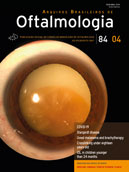PURPOSES: We analyzed patient, tumor and dosimetric characteristics of subjects in a Spanish population diagnosed with uveal melanoma treated with iodine 125 (I125) episcleral brachytherapy, who presented with post-treatment loss of useful visual acuity and global evolution of visual acuity.
METHODS: A single historic observational cohort study was undertaken. Patients with uveal melanoma were recruited between September 1995 and June 2015. Clinical, tumor and dosimetric data collection and visual acuity evaluations were performed under everyday practice conditions based on a useful visual acuity >0.1 on the decimal scale. The baseline analysis was performed using descriptive and survival analyses according to Kaplan-Meier curves.
RESULTS: A total of 286 of the 665 patients diagnosed with uveal melanoma received episcleral brachytherapy, and 198 were included in the study. The mean follow-up time was 75.3 months (95% CI = 68.0-82.6). Patients with post-treatment useful visual acuity loss (n=94, 47%) presented the following characteristics: visual symptoms (n=80, p-value = 0.001); iris color (brown n=33, hazel green n=49, p-value = 0.047); Collaborative Ocular Melanoma Study size (medium n=80, p-value = 0.159); tumor, node, metastasis stage (T2: n=38, T3: n=38, p=0.012); shape (nodular n=67, mushroom-shaped n=26, p=0.001); posterior pole involvement (n=47, p=0.04); recurrence (n=10, p=0.001); and dose administered in the fovea, optic nerve and center of the eye (p<0.002). Using Kaplan-Meier analysis, the mean overall survival of useful visual acuity was 90.19 months, and the probability of preserving useful visual acuity was 66% for one year, 45% for five years and 33% for ten years.
CONCLUSION: Patients most likely to present with visual acuity loss were those with the following profile: elderly males with dark irises who were diagnosed with visual symptoms and exhibited a medium/ large melanoma with a mushroom shape in the posterior pole (near the fovea and/or optic nerve). All patients treated with episcleral brachytherapy are likely to present with visual acuity loss, which is more pronounced in the first few years following treatment.
Keywords: Melanoma; Uveal neoplasms; Iodine radioisotopes; Brachtherapy; Visual acuity
